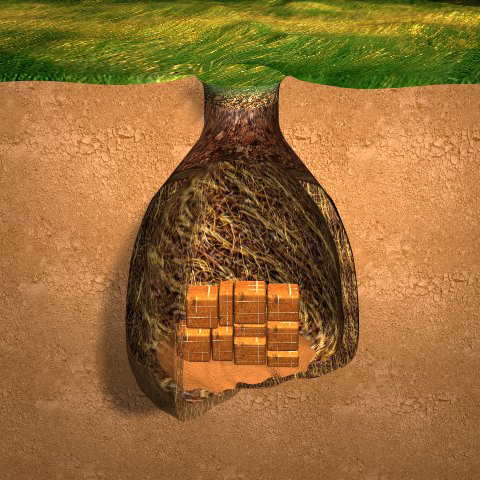At the mouth of the Marias River on 9 June 1805, the captains decided to store some of their heavier baggage, plus some excess provisions, and pick them up on their way back. They had learned from the French Canadian engagés (hired hands) who had worked for them as far as the Knife River Villages, about their method for stashing things underground. Pierre Cruzatte claimed to know the procedures, and was given the responsibility for directing the work, which Lewis described in detail:
a place being fixed on for a cash, a circle abut 20 inches in diameter is first described. the terf or sod of this circle is carefully removed, being taken out as entire as possible in order that it may be replaced in the same situation when the chash is filled and secured. this circular hole is then sunk perpendicularly to the depth of one foot, if the ground be not firm, somewhat deeper. they then begin to work it out wider as they proceed downwards until they get it about six or seven feet deep giving it nearly the shape of a kettle, or the lower part of a large still. it’s bottom is also somewhat sunk in the center. the dementions of the cash is in proportion to the quantity of articles intended to be deposited. as the earth is dug it is handed up in a vessel and carefully laid on a skin or cloth, and then carried to some place where it can be thrown in such manner as to conseal it usually into some running stream whereit is washed away and leaves no traces which might lead to the discovery of the cash. before the goods are deposited they must be well dryed; a parcel of small dry sticks are then collected and with then [them] a floor is maid of three or four inches thick which is then covered with some dry hay or a raw hide well dryed; on this the articles are deposited, taking care to keep them from touching the walls by putting other dry sticks between as you stow away the merchandise, when nearly full the goods are covered with a skin and earth thrown in and well rammed untill with the addition of the turf first removed the whole is on a level with the surface of the ground. in this manner, dryed skins or merchandize will keep perfectly sound for several years. the traders of the Missouri, particularly those engaged in the trade with the Siouxs are obliged to have frequent recourse to this method in order to avoyd being robed.
The French noun cache was derived from the verb cacher, meaning “to hide.” Captain Lewis evidently was given the French spelling, perhaps by interpreter George Drouillard, for he wrote it correctly once in his entry for June 9th, but thereafter he and the other journalists nearly always spelled it phonetically—”cash.” The word wasn’t common enough in either orthography among eastern Americans to qualify it for inclusion in Webster’s first two dictionaries (1806 and 1828). The men also dug similar hiding holes above and below the Great Falls of the Missouri, and at “Camp Fortunate.” Unfortunately, for some unknown reason the structures didn’t all meet Cruzatte’s assurances. The one at the mouth of the Marias River collapsed, ruining most of the contents, which included souvenir furs belonging to Lewis and some of the men, as well as many other personal possessions of the latter. The one at the upper portage camp at the Falls of the Missouri was inundated by spring floodwaters that destroyed all of the plant specimens Lewis had collected between Fort Mandan and the Great Falls.
In those days, to open a cache was to “raise” it. A cache that was found to have been robbed was said to have been “lifted.” Apparently none of the Corps’ caches were lifted.
Experience the Lewis and Clark Trail
The Lewis and Clark Trail Experience—our sister site at lewisandclark.travel—connects the world to people and places on the Lewis and Clark Trail.
Discover More
- The Lewis and Clark Expedition: Day by Day by Gary E. Moulton (University of Nebraska Press, 2018). The story in prose, 14 May 1804–23 September 1806.
- The Lewis and Clark Journals: An American Epic of Discovery (abridged) by Gary E. Moulton (University of Nebraska Press, 2003). Selected journal excerpts, 14 May 1804–23 September 1806.
- The Lewis and Clark Journals. by Gary E. Moulton (University of Nebraska Press, 1983–2001). The complete story in 13 volumes.


